#commercial plant nutrients
Explore tagged Tumblr posts
Text
If you aren't following the news here in the Pacific Northwest, this is a very, very big deal. Our native salmon numbers have been plummeting over the past century and change. First it was due to overfishing by commercial canneries, then the dams went in and slowed the rivers down and blocked the salmons' migratory paths. More recently climate change is warming the water even more than the slower river flows have, and salmon can easily die of overheating in temperatures we would consider comfortable.
Removing the dams will allow the Klamath River and its tributaries to return to their natural states, making them more hospitable to salmon and other native wildlife (the reservoirs created by the dams were full of non-native fish stocked there over the years.) Not only will this help the salmon thrive, but it makes the entire ecosystem in the region more resilient. The nutrients that salmon bring back from their years in the ocean, stored within their flesh and bones, works its way through the surrounding forest and can be traced in plants several miles from the river.
This is also a victory for the Yurok, Karuk, and other indigenous people who have relied on the Klamath for many generations. The salmon aren't just a crucial source of food, but also deeply ingrained in indigenous cultures. It's a small step toward righting one of the many wrongs that indigenous people in the Americas have suffered for centuries.
#salmon#dam removal#fish#animals#wildlife#dams#Klamath River#Klamath dams#restoration ecology#indigenous rights#Yurok Tribe#Karuk Tribe#nature#ecology#environment#conservation#PNW#Pacific Northwest
19K notes
·
View notes
Text
Notes as an indigenous farmer for other farmers, gardeners, looking to seek to perform land remediation, restorative agroforestry, etc.
First, look up historical weather and current weather zoning, climate change is real, the area may no longer be suitable for specific plants anymore.
Consider invasive plants, animals, worms(yes like bees there are invasive worms) , etc
Assess potential soil and water pollution sources then create a remediation plan depending on time and feasibility.
Work with the land, not against it, this is pretty simple, if you plan to create rain collecting channels for your small garden, then it's to slope where the land slopes for you.
Composting is great but you also need to understand microbial/fungal symbiosis and creating microbiomes that allow for effective compost break down.
You can buy cheap microbial solutions that are epa or environmental sound, back reference any microbial cultures with academic papers, if unsure how to do the research then it is fine with a variety as this simulates closely to nature.
Look into outdoor mushroom farming, this is pretty common in my community in our Chināmitl /mīlpan system, it's not as hard as most resources online will tell you, especially if you're sticking with native to your area mushrooms.
Avoid commercial strains for cultures especially if they're non native as this can lead to potential invasives.
Yes fungus /mushrooms can be invasive, please never put golden oyster outside.
You can also buy microremediating solutions for soil/water contamination.
Many universities offer resources to help find soil or water testing companies for accessible to no costs even, this is useful if you want to assess variety of conditions.
Additionally microbe /fungal based solutions are most used in our community as it helps reduced overall pests and diseases to our plants.
If you have tons of untreated wood ash (burn untreated wood, get wood ash) this is useful for variety of things, as this ties into controlled burning, true slash and burn, etc. Essentially nutrients are allowed to disperse back in the ground, be aware of heavy metal and other contamination considerations as always.
Indigenous seed banks do exist for non indigenous people, also look into seed conservation projects and seed banks that look to preserve seed lineages. While heirloom is nifty, it does only go so far back around an early colonial era.
54 notes
·
View notes
Text
PSA: the vast majority of commercial dog food is terrible for your dog, and you cannot feed a dog a "vegan" (or vegetarian) diet.
Dogs are what is called facultative carnivores, meaning they can and will eat food that is not part of their typical, ideal diet if circumstances call for it. This is why they are often called omnivores (the line between facultative carnivores and omnivores is debated). Comparatively, obligate carnivores, like cats, cannot process non-carnivorous food at all.
This means that although the primary and default diet of domesticated dogs is other animals, dogs' digestive systems are capable of digesting other food sources like plants if a carnivorous option is not available: in other words, if they're hungry enough, they can "get by" on less ideal food sources.
Although dogs' systems can tolerate some plant material in their diet, they will not thrive on a long-term diet high in carbohydrates. This is because while dogs' pancreases do produce amylase (the enzyme that breaks down carbs), it's not nearly as much as true omnivores like humans, and can even vary quite a bit from dog-to-dog. They also don't produce cellulase at all. So a diet high in plant material for too long can be hard on their systems and lead to long-term serious health affects that will shorten their lifespan, such as early organ failure and heart disease - yes, even if they "seem great" on the day-to-day.
Ideally, a dog's diet should not be more than 15% plant material. However, the vast majority of commercial dog food is only 30% animal-derived ingredients, because 30% is the industry required minimum in order to be commercially sold. Even a lot of brands that boast about having "high animal protein" are often only hitting the 60% benchmark. Why? Because plant foods like legumes, sweet potatoes, and grains are a much, much cheaper way to "bulk up" the dog food than using 85-95% animal products. And then they artificially add in a ton of vitamins and nutrients to make them "nutritionally complete" (because plant nutrients are less bioavailable to carnivores), whereas a dog would easily get them from a diet with correctly proportioned inclusions of organs and bones.
Don't even get me started on ""vegan"" dog foods. A diet that is 100% plant based is straight up animal cruelty for a facultative carnivore like dogs and you cannot change my mind. You're literally taking years off your pet's lifespan in the name of your ideology. If you want a pet you can feed a completely plant-based diet without consequence, get a rabbit.
Unfortunately, there is no such thing as an easy or cheap pet, and dogs aren't an exception. I understand that feeding a dog a proper diet is an expensive venture. The best dog food you can buy at the pet store will still be below the ideal, and it will cost $$$. Just do the best you can for your circumstances. Even occasionally swapping commercial food for a little raw animal supplementation can help. Avoid kibble with legumes or potatoes.
And if you're thinking of getting a dog... I mean this gently, but you need to seriously consider whether you can actually afford to feed them. Don't get pets unless you can afford all the care they require.
68 notes
·
View notes
Text
Crown of Glory: A Hair Growth Working
This is a simple working that is meant to be a fun addition to your hair care routine. I am using this as a weekly hair oil treatment. Feel free to use all of it, parts of it, or none at all. It’s your hair journey, so make it your own! Go wild and create your own working if you would like, too. I will post updates in the next few months of the results.
Hair, that crowning glory atop our heads, has long been revered as a symbol of power, vitality, and spiritual connection. It is said to be an extension of the self, a tangible manifestation of inner strength and identity. In bygone eras, hair was so cherished that its loss was often seen as a sign of misfortune or a weakening of the spirit.
This working is a form of Wortcunning, where magick and medicinal plant knowledge intertwine. This hair growth oil is infused with herbs known to help stimulate hair growth, combat hair loss & thinning hair, breakage, and nourish the scalp. It is essential to remember that while magick can be a potent tool, it is not a replacement for proper hair care and a healthy lifestyle. Nourish your body from within, and let this working be a catalyst for transformation.
As with all workings, approach this spell with reverence and intention. Harness the power of nature and your own inner strength to cultivate a Crown of Glory worthy of royalty.
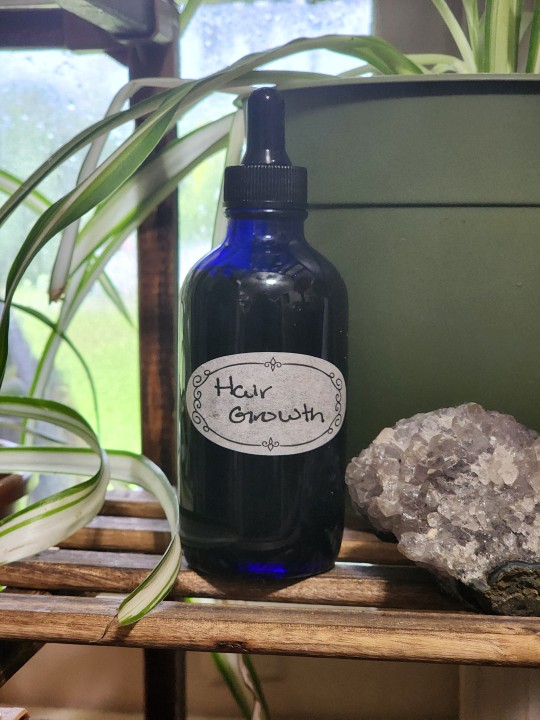
Ingredients for the Crown of Glory Hair Growth Oil:
To harness the power of nature for lush, thriving hair, I have carefully selected a blend of potent herbs and oils.
Rosemary: Renowned for its hair-growth-stimulating properties, rosemary has been shown to rival the effects of commercial hair growth treatments.
Nettle Root: Rich in nutrients, nettle root helps combat hair loss by inhibiting DHT, a hormone linked to thinning hair.
Saw Palmetto Berries: Traditionally used to address hair loss, Saw Palmetto Berries offers support for overall hair health.
Garden Sage: Stimulating blood circulation to the scalp, sage encourages thicker hair growth and pairs beautifully with rosemary.
Horsetail (Herb): Packed with silica, this herb strengthens hair strands, preventing breakage and promoting growth.
Evening Primrose Oil: Nourishing both new and existing hair, evening primrose oil contributes to longer, healthier locks.
Safflower Oil: A lightweight carrier oil, safflower oil aids in absorption of the herbal properties while also stimulating hair growth at the cellular level, and nourishes the scalp. Liquid Coconut Oil can also be used.
To maximize the potency of the ingredients, the oil infusion process spanned a full 30-day moon cycle. However, a rapid infusion method can also be employed for those seeking a quicker remedy. There are plenty of resources and videos on YouTube on both of these methods.
______________________________________________________________
Ingredients Used For Working:
I painted my workspace with chalkboard paint, but don't worry if you can't! Any flat surface or even paper will work as long as your candles are safe and sound in holders while burning.
Hair Growth Oil or Your favorite hair growth oil
4 green candles ( I used chime candles)
Green chalk (white is a good sub)
Blessing oil (I use a mix of Frankincense & Myrrh with clear quartz crystal inside the bottle... all charged by a full moon)
A Bluetooth speaker
Frankincense & Myrrh Incense Cones
____________________________________________________________
Steps For My Working:
First, let's get your space ready for magick! Cleanse everything up, and give your candles and tools a little cleansing & consecrating. I love burning Frankincense & Myrrh incense for this part.
Next, you can write "Hair Growth" or whatever phrase/keywords work for you on your green candles, starting from the bottom and going up. Put them safely in their holders and drip your blessing oil on each candle.
Next, draw a spiral with green chalk, starting from the outside and working your way in. Then, draw little arrows pointing from your candles to the spiral. This is like focusing all the candle magick into one powerful spot!

Now at the spiral's heart, position the speaker and place your bottled hair growth oil on top of the speaker. I used a hair growth frequency to pulse through it, like a sonic energy spell to charge and attune the oil.
youtube
Then you will want to turn on the music and light those candles. Remember to light them going clockwise – it's like winding up the working.

Now as the music plays and the candles flicker, close your eyes and picture your Crown of Glory! While you’re visualizing your dream hair, say this:
By the power of nature's might, May my hair grow strong and bright. Roots deep, strands long and free, A crown of glory, wild and free. Grow, my locks, strong and deep, Let ancient powers your spirit keep. With every drop, a potent spell, To break the bonds where tresses dwell. Crown my head with growth anew, May hair flourish, strong and true. Let follicles awaken, deep and sound, As vital force is richly found. As this oil is blessed and shaken, May hair growth be fully awakened.
When all the candles are finished burning, you can clean up your space. You can throw away or recycle things as you normally would.
____________________________________________________________
May the Gods, Goddesses, and Moon bless your workings, and may the universe conspire in your favor. Happy Casting Seekers!
#traditional witchcraft#witchcraft#witch#magick#witchblr#spellcasting#pagan witch#green witch#green magic#witches#folk witchcraft#folk magic#hair magick#spirituality#green witchcraft
32 notes
·
View notes
Text
Moth of the Week
African Wild Silk Moth
Gonometa postica

The African wild silk moth is a part of the family Lasiocampidae. It was first described in 1855 by Francis Walker. It is also known as the Brandwurm in its larval stage in Afrikaans, Kweena in its pupal stage in Tshwana, and Molopo moth/mot in English and Afrikaans.
Description The female of this moth is much longer and larger than the male due to having to carry eggs. The male is about half the size of the female and much thinner.
The female has a light brown abdomen with a dark brown thorax and head. The female’s forewings are striped light brown, dark brown, and gray. The hindwings are a yellow-brown with a dark brown edge.
The male has a dark body and wings with a transparent portion of the hindwing.
Female Forewing Range: 35–42 mm (
Male Forewing Range: 21–25 mm (
Diet and Habitat Larva of this species eat Acacia erioloba, A. tortilis, A. melifera, Burkea africana, Brachystegia spp., and Prosopis glandulosa. The larva will feed from the same tree it’s entire life unless there are two many other caterpillars. When there is a large number of caterpillars, they may defoliate the whole tree and the larva must move in order to not starve.
This moth mainly inhabits savannas with many Acacia trees, especially in drier areas. These moths contribute to the Acacia environment by providing food to predators and nutrients to plants through feces. Cocoons are usually found on Acacia tees.
Mating Males detect females’ mating pheromones with their antennae. Males fly to the females because the females are weighed down by the eggs. The female contains about 200 eggs which are laid on the food plant after fertilization. Eggs hatch in about two weeks. Eggs are laid in clumps and the newly hatched caterpillars grow as a group and become more solitary with time.
Predators This moth is preyed on by parasitic wasps and flies. These insects lay their eggs on the caterpillar and feed off of its resources until the moth larva cocoons. The parasites live off the cocoon and grow to adulthood while killing the pupa. Specifically, these larva are subject to parasitism by Diptera and Hymenoptera, the most common parasitoids being Palexorista species from the Tachinidae and Goryphus species from the Ichneumonidae.[6]
To combat external predators and weather, the caterpillars build a tough cocoon. Caterpillars and their cocoons are also covered in stinging hairs to deter predators from touching them. Female cocoons are larger than male cocoons.
Fun Fact In Madagascar, wild silk has been harvested for centuries, and this knowledge has been introduced to southern Africa. The cocoons are harvested commercially in Namibia, Botswana, Kenya and South Africa, and the species also occurs in Zimbabwe and Mozambique. They are difficult to harvest due to the cocoons being covered in calcium oxalate. Oxford University discovered and patented a method known as demineralizing using a warm solution of EDTA (ethylenediaminetetraacetic acid) that soften the cocoons by dissolving the sericin. This lets the silk unravel without weakening it.
- Wild African silk moth cocoons are also used as ankle rattles in southern Africa by San and Bantu tribes. They are filled with materials such as fine gravel, seeds, glass beads, broken sea shells, or pieces of ostrich eggshell.
- Furthermore, the cocoons have long been known to cause the death of cattle, antelope and other ruminants in the Kalahari. During drought periods, the cocoons are eaten, probably because they resemble acacia pods. The silk is indigestible and blocks the rumen of multiple-stomach animals, causing starvation.
- Finally, the protein found in this species’s slik contains many basic amino acids making it a potentially useful biomaterial in cell and tissue culture.
(Source: Wikipedia, SANBI)
#libraryofmoths#animals#bugs#facts#insects#moth#lepidoptera#mothoftheweek#African wild silk moth#Gonometa postica#Lasiocampidae#double post
90 notes
·
View notes
Note
Mosses are small, non-vascular flowerless plantsin the taxonomic division Bryophyta(/braɪˈɒfətə/,[3] /ˌbraɪ.əˈfaɪtə/) sensu stricto. Bryophyta (sensu lato, Schimp. 1879[4]) may also refer to the parent group bryophytes, which comprise liverworts, mosses, and hornworts.[5]Mosses typically form dense green clumps or mats, often in damp or shady locations. The individual plants are usually composed of simple leaves that are generally only one cell thick, attached to a stem that may be branched or unbranched and has only a limited role in conducting water and nutrients. Although some species have conducting tissues, these are generally poorly developed and structurally different from similar tissue found in vascular plants.[6] Mosses do not have seeds and after fertilisation develop sporophytes with unbranched stalks topped with single capsules containing spores. They are typically 0.2–10 cm (0.1–3.9 in) tall, though some species are much larger. Dawsonia, the tallest moss in the world, can grow to 50 cm (20 in) in height. There are approximately 12,000 species.[2]Moss
Temporal range: Carboniferous[1]–present
PreꞒ
Ꞓ
O
S
D
C
P
T
J
K
Pg
NClumps of moss on the ground and base of trees in the Allegheny National Forest, Pennsylvania, United StatesScientific classificationKingdom:PlantaeClade:EmbryophytesClade:SetaphytaDivision:Bryophyta Schimp. sensu strictoClasses[2]
Takakiopsida
Sphagnopsida
Andreaeopsida
Andreaeobryopsida
Oedipodiopsida
Polytrichopsida
Tetraphidopsida
Bryopsida
Synonyms
Musci L.
Muscineae Bisch.
Mosses are commonly confused with liverworts, hornworts and lichens.[7] Although often described as non-vascular plants, many mosses have advanced vascular systems.[8][9] Like liverworts and hornworts, the haploidgametophyte generation of mosses is the dominant phase of the life cycle. This contrasts with the pattern in all vascular plants (seed plantsand pteridophytes), where the diploid sporophyte generation is dominant. Lichens may superficially resemble mosses, and sometimes have common names that include the word "moss" (e.g., "reindeer moss" or "Iceland moss"), but they are fungal symbioses and not related to mosses.[7]: 3
The main commercial significance of mosses is as the main constituent of peat (mostly the genus Sphagnum), although they are also used for decorative purposes, such as in gardens and in the florist trade. Traditional uses of mosses included as insulation and for the ability to absorb liquids up to 20 times their weight.
GUYS I FOUND BERDLY
163 notes
·
View notes
Note
weird question, but do you know if regenerative agriculture is growing, and by what rate? it's important to me but looking for articles on my own can trigger a panic attack :[ no worries if not !
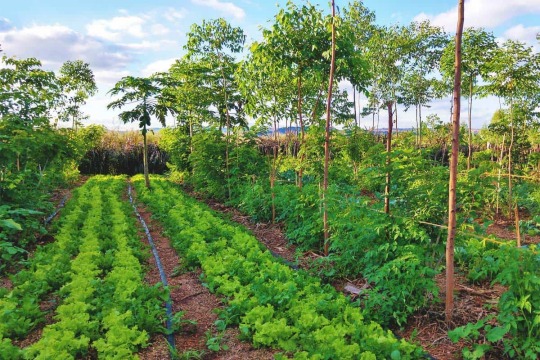
Hey! Thank you so much for asking. Honestly, agriculture and sustainable agriculture specifically are very close to my heart as well, so I was glad for the excuse to do some research :)
Also, thank you for your patience, I know you sent this Ask a bit ago. It’s good that you’re listening to yourself and not going around searching for things that might cause you harm, so thanks again for reaching out!
So, what is regenerative agriculture?
Regenerative agriculture is a way of farming that focuses on soil health. When soil is healthy, it produces more food and nutrition, stores more carbon and increases biodiversity – the variety of species. Healthy soil supports other water, land and air environments and ecosystems through natural processes including water drainage and pollination – the fertilization of plants.
Regenerative agriculture is a defining term for sustainability in our food system - while there is no one true definition of regenerative agriculture, the concept has been around for centuries, taking root in Indigenous growing practices. Regenerative approaches can bolster soil health and watershed health. They can also add to climate mitigation and potentially tie into regulatory or commercial incentives for a more sustainable diet.
Regenerative farming methods include minimizing the ploughing of land. This keeps CO2 in the soil, improves its water absorbency and leaves vital fungal communities in the earth undisturbed.
Rotating crops to vary the types of crop planted improves biodiversity, while using animal manure and compost helps to return nutrients to the soil.
Continuously grazing animals on the same piece of land can also degrade soil, explains the Regenerative agriculture in Europe report from the European Academies’ Science Advisory Council. So regenerative agriculture methods include moving grazing animals to different pastures.
How can it help?
Regenerative farming can improve crop yields – the volume of crops produced – by improving the health of soil and its ability to retain water, as well as reducing soil erosion. If regenerative farming was implemented in Africa, crop yields could rise 13% by 2040 and up to 40% in the future, according to a Regenerative Farming in Africa report by conservation organization the International Union for Conservation of Nature and the UN.
Regenerative farming can also reduce emissions from agriculture and turn the croplands and pastures, which cover up to 40% of Earth’s ice-free land area, into carbon sinks. These are environments that naturally absorb CO2 from the atmosphere, according to climate solutions organization Project Drawdown.
5 ways to scale regenerative agriculture:
1. Agree on common metrics for environmental outcomes. Today, there are many disparate efforts to define and measure environmental outcomes. We must move to a set of metrics adopted by the whole food industry, making it easier for farmers to adjust their practices and for positive changes to be rewarded. 2. Build farmers’ income from environmental outcomes such as carbon reduction and removal. We need a well-functioning market with a credible system of payments for environmental outcomes, trusted by buyers and sellers, that creates a new, durable, income stream for farmers. 3. Create mechanisms to share the cost of transition with farmers. Today, all the risk and cost sits with the farmers. 4. Ensure government policy enables and rewards farmers for transition. Too many government policies are in fact supporting the status quo of farming. The food sector must come together and work jointly with regulators to address this. 5. Develop new sourcing models to spread the cost of transition. We must move from sourcing models that take crops from anywhere to models that involve collaboration between off-takers from different sectors to take crops from areas converting to regenerative farming.
The rise of regenerative agriculture
In 2019, General Mills, the manufacturer of Cheerios, Yoplait and Annie’s Mac and Cheese (among other products), announced it would begin sourcing a portion of its corn, wheat, dairy and sugar from farmers who were engaged in regenerative agriculture practices and committed to advancing the practice of regenerative agriculture on one million acres of land by 2030. In early 2020, Whole Foods announced regenerative agriculture would be the No. 1 food trend and, in spite of the pandemic and the rapid growth of online shopping overshadowing the trend, business interest in the field still spiked by 138%.
More recently, PepsiCo announced it was adopting regenerative agriculture practices among 7 million acres of its farmland. Cargill declared it intends to do the same on 10 million acres by 2030, and Walmart has committed to advancing the practice on 50 million acres. Other companies pursuing regenerative agriculture include Danone, Unilever, Hormel, Target and Land O’ Lakes.
According to Nielsen, 75% of millennials are altering their buying habits with the environment in mind. This sentiment, of course, does not always materialize into tangible actions on behalf of every consumer. However, it is clear from the actions of PepsiCo, General Mills, Walmart, Unilever and others that they believe consumers’ expectations of what is environmentally friendly are shifting and that they will soon be looking to purchase regeneratively-produced foods because of the many benefits they produce.
The next step in the transition to regenerative agriculture is certification. The goal is to create labeling that will allow the consumer to connect to the full suite of their values. Some companies are partnering with nonprofit conveners and certifiers. The Savory Institute is one such partner, convening producers and brands around regenerative agriculture and more holistic land management practices.
In 2020, the Savory Institute granted its first “Ecological OutCome Verification (EOV) seal to Epic’s latest high protein bars by certifying that its featured beef was raised with regenerative agriculture practices.
The program was developed to let the land speak for itself by showing improvement through both leading and lagging functions such as plant diversity and water holding capacity. There are now thousands of products that have been Land to Market verified, with over 80 brand partnerships with companies such as Epic Provisions, Eileen Fisher and Applegate. Daily Harvest is giving growers in that space three-year contracts as well as markets and price premiums for the transitional crop. It's focusing on that transitional organic process as a stepping stone toward a regenerative organic food system.
Daily Harvest’s Almond Project creates an alliance with the Savory Institute and a group of stakeholders - including Simple Mills and Cappello’s - to bring regenerative practices to almonds in the Central Valley of California.
These companies are working with Treehouse California Almonds, their shared almond supplier, to lead soil health research on 160 acres of farmland. Over five years, the Project will focus on measuring outcomes around the ecosystem and soil health of regenerative practices – comparing those side by side with neighboring conventional baselines.
“We need industry partnership; we need pre-competitive collaboration,” says Rebecca Gildiner, Director of Sustainability at Daily Harvest, of the Almond Project. “Sustainability cannot be competitive. We are all sharing suppliers, we are all sharing supply – rising tides truly lift all boats. The industry has to understand our responsibility in investing, where historically investments have disproportionately focused on yields with a sole focus of feeding the world. We know this has been critical in the past but it has overlooked other forms of capital, other than financial. We need to look towards experimenting in holistic systems that have other outcomes than yield and profit - instead of saying organic can’t feed the world, we have to invest in figuring out how organic can feed the world because it’s critical.”
////
In short!!!
Many articles are stating regenerative agriculture as a defining, and rising “buzz word” in the industry. It seems that consumers are becoming more and more aware and are demanding more sustainable approaches to agriculture.
We, of course, have a way to go, but it seems from the data that I’ve gathered, that regenerative agriculture is, in fact, on the rise. Demand is rising, and many are working on ways to globalize those methods.
Source Source Source Source
#climate change#climate#hope#good news#climate news#climate crisis#more to come#climate emergency#news#climate justice#agriculture#ecosystem#farming#conservation#biodiversity#regenerative agriculture
86 notes
·
View notes
Text
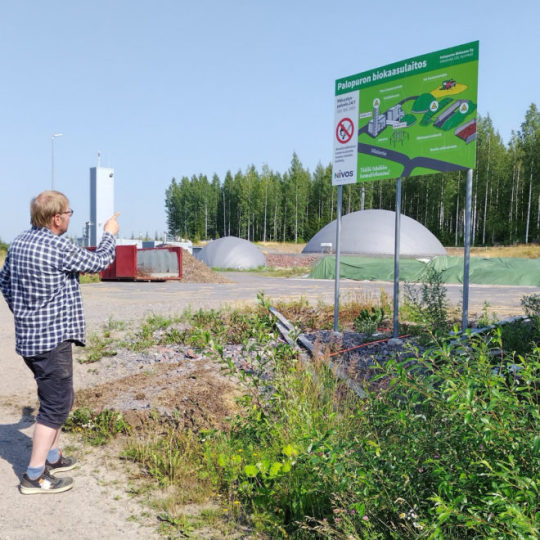
Self-sufficient organic Finnish farm grows its own fuel and a greener future
An award-winning farm has teamed up with Helsinki University to create a symbiotic food production system that is self-sufficient in energy and nutrients. It’s a trailblazer in sustainable agriculture.
Photo above: Farmer Markus Eerola shows visitors the biogas plant that helps make his farm an energy producer rather than an energy consumer.Photo: Wif Stenger
Organic Knehtilä Farm provides its own nutrients and energy, thanks to careful long-term planning and a small onsite biogas plant operated by energy utility Nivos.
The biogas powers his tractor, pickup truck and cars, and is available to others at a commercial filling station on the edge of the farm, although vehicles that can use biogas are still relatively rare. It offers a valuable alternative to meet the growing need for affordable, clean domestic energy.
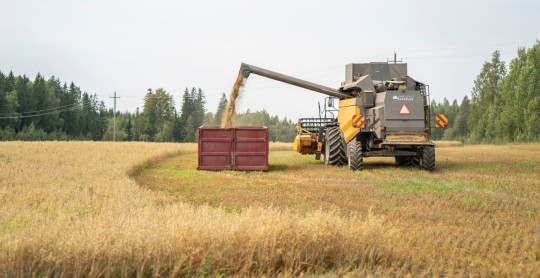
Demand for organic food continues to grow. “The price gap between organic and standard production is narrowing, partly because we don’t need fertiliser. Our farm has its own product line of oat and buckwheat products, which are produced here using a proven cultivation method known as agroecological symbiosis, where nutrients and energy are efficiently recycled.”
The sprawling 380-hectare farm’s carefully balanced circular economy has developed over a decade and a half, earning a WWF award in 2015 as a model of nature-friendly agriculture. In 2021, the Finnish Organic Association chose Knehtilä for the honour of Organic Business of the Year.
“Biogas production can convert farms from being energy consumers to energy producers, and play an important role in the transition away from fossil fuels. When it’s done in a smart way, it’s also possible to increase biodiversity in farming systems.”
Knehtilä forms part of the Global Network of Lighthouse Farms, a project led by Wageningen University in the Netherlands, involving commercially viable farms that offer “radical solutions to address sustainability challenges.” International visitors frequently come to Knehtilä to learn about unique system.
The rich, vibrant cycle of life at Knehtilä is visible in not only the lush fields, but also in the insects and frogs that frequent them, and in a few animals such as horses, sheep, goats, chickens and rabbits. The farm is also a lively event venue; a high-ceilinged, 80-year-old barn has been converted to a space for up to 100 people for weddings, theatre performances and concerts.
#solarpunk#solar punk#indigenous knowledge#reculture#self reliant farming#agroecology#biogas#finland#organic farming#design
34 notes
·
View notes
Text

The U.S. Department of Agriculture (USDA) National Institute of Food and Agriculture (NIFA) announced today an investment of $70 million in seven creative and visionary agricultural projects to transform the U.S. food and agricultural system and sustainably increase agricultural production in ways that also reduce its environmental footprint.
This Fiscal Year 2023 investment is part of the Sustainable Agricultural Systems program area of NIFA’s Agriculture and Food Research Initiative, the nation’s leading and largest competitive grants program for agricultural sciences.
The innovative program focuses on a broad range of needed research, education and Extension solutions – from addressing agricultural workforce challenges and promoting land stewardship to addressing climate change impacts in agriculture and filling critical needs in food and nutrition.
“Agriculture is facing a multitude of complex challenges,” said Dr. Chavonda Jacobs-Young, USDA Chief Scientist and Under Secretary for Research, Education and Economics. “We need all hands on deck developing creative, sustainable and strategic ways to feed, clothe and fuel future generations.”
The $10 million awards are for coordinated agricultural projects (CAPs), which are larger-scale and longer-term investments that integrate research, education and Extension efforts. These projects promote collaboration, open communication, information exchange and reduce duplication efforts by coordinating activities among individuals, institutions, states and regions.
“These research investments support exciting projects that integrate innovative systems-based thinking, methods and technologies to establish robust, resilient, and climate-smart food and agricultural systems,” said NIFA Director Dr. Manjit Misra. “These visionary projects will improve the local and regional supply of affordable, safe, nutritious and accessible food and agricultural products, while fostering economic development and rural prosperity in America.”
Explore the seven projects, which include the following:
At the University of Wisconsin-Madison, Dr. Erin Silva is leading a collaboration with the Great Lakes Intertribal Food Coalition, the Wisconsin Tribal Conservation Advisory Council, and the Menominee Nation on a transdisciplinary project that aims to scale up traditional Indigenous food production practices — practices that for generations have already been climate-smart and sustainable — by expanding production, processing, storage, and distribution systems, as well as education and Extension programs, that are needed to support integrated crop-livestock systems, cover crops, and rotationally-grazed cattle and pastured chickens.
At the University of Maine, Dr. Hemant Pendse is leading an integrated research, education and Extension effort to advance the bioeconomy by developing biorefinery technologies that will make the millions of tons of available low-grade woody biomass – which currently has a very limited market – more commercially viable in both the sustainable aviation fuel and fish feed sectors.
At Texas A&M AgriLife Research, Dr. Muthu Bagavathiannan is leading a project that seeks to transform cotton production in the southern United States into a more sustainable, climate-smart enterprise by applying improved precision management practices to increase carbon sequestration and reduce greenhouse gas emissions; enhance pest control, and nutrient and water management; and address labor challenges while creating new market opportunities.
AFRI, which also makes grants in the Foundational and Applied Sciences and Education and Workforce Development program areas, is designed to improve plant and animal production and sustainability, and human and environmental health. Grants are available to eligible colleges, universities, and other research organizations.
#good news#environmentalism#agriculture#usa#sustainable farming#sustainability#indigenous food ways#indigenous#science#environment#nature#climate change#climate crisis
25 notes
·
View notes
Text
Wheat on repeat (Anthropocene Magazine)
Excerpt from this story from Anthropocene Magazine:
Disguised within an ordinary-looking bowl of pasta before me is a brand new ingredient, 20-years in the making, that many believe could single-handedly slash emissions, store carbon in the soil, and help the wider environment.
The neat fusilli coils contain flour ground from Kernza, a perennial wheat-like crop that produces multiple harvests from one plant, year after year after year. I received some cooking instructions to get the best out of the novel ingredient: “Don’t cover it up with a bunch of sauce! Make sure you can taste it,” says Lee DeHaan, a scientist at The Land Institute, a non-profit agriculture research organization based in Salina, Kansas, that developed the Kernza grain. I follow his guidance, drizzling in a little olive oil and a pinch of salt, and then take a bite, letting the pasta’s flavors emerge: a subtle but unmistakable hint of cinnamon, followed by nutmeg. It’s unexpectedly warm and earthy, like a salute to the rich Kansas soils that Kernza first sprouted from.
The way this crop was raised there was very different to its cousin, conventional wheat. Wheat is an annual crop, like rice and corn, which together account for almost half of the calories humanity consumes. Annuals must be planted and harvested anew each year, a system that requires farmers to heap fertilizers and herbicides onto the land, dispersed by gas-guzzling machinery that bloats agriculture’s carbon footprint. Meanwhile, repeated cycles of tilling and replanting strips the soil of nutrients, and loses vital topsoil to wind and rain. Over time, those soils may degrade, pushing farmers onto new land in search of fertile ground.
Each mouthful of this Kernza-rich pasta, on the other hand, supports farming that locks topsoil in place and stores carbon in the earth. A growing movement of researchers, farmers, and producers believe that perennial crops have unmatched potential to reform agriculture’s warped system, and are pinning their hopes—and research dollars—on the likes of Kernza to deliver that. The grain is now cultivated across 4,000 acres of land, by over 100 farmers across the US Midwest and as far afield as Sweden and France. Its distinct aromas have made their way into craft beers, cereals, crackers, and whiskey, and have been embraced by major brands such as Patagonia.
As a potential substitute for wheat, which covers more global land area than any other commercial crop, Kernza seems to herald a wholesome, low-carbon revolution in the vast agricultural sector. And yet 15 years since the first stands took root, the crop has only managed to capture a tiny fraction of the market, a victim of limited yields, government regulation, and a conservative farming industry. So can Kernza ever displace traditional amber waves of grain, or is it doomed to be a perennial runner-up?
12 notes
·
View notes
Text
Scientists use a refrain to sum up in the impact of earthworms [...]: “Good in your garden, bad in the forest.” It’s a quip that can sometimes come as a surprise to people used to thinking of earthworms as symptoms of healthy soil.
In Canada’s northern forests, there’s increasing evidence of a worm problem.
According to research from 2013, tiny soil invertebrates, like mites and springtails, decrease in abundance by more than 50 percent when earthworms are present. These minute creatures play an important role in the decomposition and nutrient-cycling of plants, and their decline can likely be attributed to the rapid way earthworms devour leaf litter. [...] And earthworms, it seems, are spreading everywhere. Research on their presence in northern US forests, where invasions are more advanced, suggests that they could have cascading effects including everything from more severe drought to greater human allergies. [...]
[N]early all native species of earthworms in Canada were wiped out over 12,000 years ago, during the last period of glaciation. Earthworms, we now know, have been present in southern Canada for only a few short centuries, the first having hitched a ride with colonizing Europeans [...].
---
Lumbricus terrestris -- the common earthworms people find in their gardens, which are often called dew worms or Canadian nightcrawlers in fishing circles -- are one of the worm species that were transported from Europe and have settled into their new home so successfully that they’ve emerged as a valuable commodity. According to Steckley’s later research on the subject, demand for these worms as fishing bait exploded as recreational fishing became popular in the wake of the Second World War. But earthworms defy attempts at commercial cultivation and have to be plucked from the wild.
In the 1980s, southwestern Ontario, with its rich soil, abundant volume of introduced nightcrawlers, and steady supply of immigrant labour, quickly eclipsed the other worm-producing regions of North America. By the time Steckley drove past the worm pickers,
Ontario had become the epicentre of global nightcrawler production, with an estimated 500 million to 700 million worms picked and shipped across North America every year.
---
Steckley, who is now a doctoral candidate at the University of Toronto researching Ontario’s bait-worm industry, says that he was actually right about his initial impression: there were bags of money in that farmer’s field, at least in the figurative sense. Worm pickers usually make around $30 per 1,000 worms, and a picker in the right conditions can scoop up to 20,000 worms a night.
“Farmers who rent their land [for an entire year] can make more from worm pickers than any other crop that they feasibly plant,” says Steckley, who’s heard of rents of up to $1,500 an acre. The industry is worth around $230 million today, Steckley estimates.
Despite the spread, Steckley says there have been few efforts to regulate its downstream environmental effects -- in fact, most people he’s encountered have been unaware that earthworms are invasive. [...]
---
But, in the boreal forest, most of the carbon is stored in organic matter -- that thick layer of fallen leaves, roots, moss, and rotting wood that, under normal conditions, decomposes slowly. But deep-burrowing earthworms feed on this material [...]. Justine Lejoly, who is conducting doctoral work with the University of Alberta and the Canadian Forest Service, found that, in some invaded parts of the Canadian boreal, 96 percent of this layer has disappeared. “Most of the forest floor is gone, so that means a lot of carbon is gone,” she says. This finding, which Lejoly made alongside her supervisor Sylvie Quideau is striking because 28 percent of the boreal forest is found in Canada and as much as one-third of terrestrial carbon is stored in the boreal worldwide. [...]
---
Text by: Moira Donovan. “Revenge of the Earthworms.” The Walrus. With illustration by Joey Ng. 13 June 2022. [Bold emphasis and some paragraph breaks added by me.]
106 notes
·
View notes
Text
I do animal rights activism and I think the population in general has absolutely 0 clue how stupid they are because of the animal ag industry and prejudice in general. there is a world of information people dont know about because they wont consider the reality of animals.
The amount of people, even atheist people, who will argue with me at outreach that humans aren't animals is truly staggering. We are great apes in the same family as chimps, gorillas, bonobos and orangutans, in case you didn't know. We are living beings in the kingdom animalia and are made of the same flesh blood bone and neurons and no we dont have the most neurons nor the most complex brains of any animal.
They will also argue things like "fur and hair are different" (they are not, they are chemically the exact same thing, fur is simply the word for hair from a nonhuman. hair can also be used to describe hair from a nonhuman, like dog hair, but human hair cannot be called fur for no other reason than it goes against the definition)
They also tend to not understand the difference between "essential nutrient" and "dietarily essential nutrient", and wont understand that even dietarily essential nutrients can and often are synthesized (like in iv nutrient bags that must be sterile, or plant based commercial cat food, various supplements and products).
5 notes
·
View notes
Text
youtube
You cannot commercially harvest a 3 Sisters field (corn, beans, pumpkins) because tractors would crush the squash, maybe harvest some of the beans, and maybe harvest some of the corn. It just cannot be done.
But it IS more nutrient-rich for the plants. The beans provide nitrogen via their nodules, the squash (planted last, after the beans, so the beans get to grow up a bit first) shades out and thus weakens /reduces weeds (and reduces the needs for herbicides, which can harm the plants), the corn provides a surface for the bean vines to climb, and each plant needs a different ratio of minerals, etc, from the soil, so they're not competing nearly as much with each other as you'd think. (The beans being a nitrogen-fixer certainly helps!)
5 notes
·
View notes
Note
Fun fact about orchids, the reason growing them from seed is hard is because wild orchids are parasites that get their nutrients from fungus they absorb as a seed that feeds them all their lives. That's how some orchid species are able to survive in low light, they don't need to photosynthesize as much as plants without a fungal symbiote (although they still can photosynthesize!) most commercial orchids are grown in a media with just a sugar that feeds the seed, so they don't have fungi to take care of them.
Orchid reproduction is WILD. I got curious about it and looked it up a while back and all this is 100% correct, orchid seeds are like you know what? I don't need an "endosperm" to provide """nutrients""", I'll just rely on a fungus to do all that for me. Orchids looked at other plants who created this novel way of reproduction where everything a baby plant needs is packaged in around them so they are self sufficient and can rely on stored energy to boost their growth until they develop enough to provide their own food, and they went LOL. Suckers. Fungus time.
#asks#orchids#oatplant#the only thing more insane than orchid reproduction is fern reproduction#spores are wild
18 notes
·
View notes
Text
Bananas Are At Risk of Extinction, But Scientists Have a Plan
A Fungus That Can Infect Over 100 Different Plants is Devastating the Popular Fruit.
— By Laura Baisas | August 16, 2024
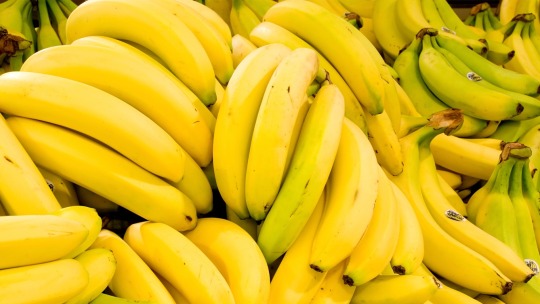
Fighting a fungal pathogen on the molecular level is key to the banana’s survival. Deposit Photos
The bright bananas dotting your fruit bowl are in some serious trouble. A popular type of banana is facing extinction from a fungal pathogen. The disease Fusarium wilt of banana (FWB) blocks the flow of nutrients to the fruit and makes it wilt. During the 1950s, the pathogen wiped out commercial banana crops and made one species–Gros Michel bananas–functionally extinct.
But not all is lost for this colorful fruit. New research from an international team of scientists has pinpointed the molecular mechanisms behind the microbe that destroys bananas and it opens the door to new treatments and strategies against the pathogen. The findings are detailed in a study published August 16 in the journal Nature Microbiology.
What Is Hurting Bananas?
The crop failures are due to a fungal pathogen with a very long name–Fusarium oxysporum f.sp. Cubense (Foc) tropical race 4 (TR4). Abbreviated as Foc TR4, this fungus decimated several banana crops in the 1950s and wiped out one entire species, but bananas aren’t the only plants at risk.
“As a species complex, Fusarium oxysporum can infect over 100 different plant hosts,” study co-author and University of Massachusetts Amherst molecular biologist Li-Jun Ma tells Popular Science.”
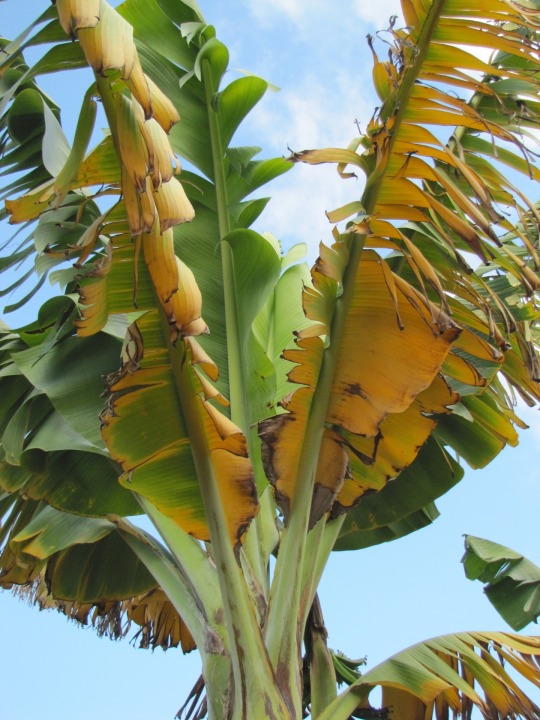
Fusarium wilt of banana is currently decimating the Cavendish banana—the world’s most popular commercially available banana. Once present in a banana field, the fungus cannot be eradicated, making future production of Cavendish bananas almost impossible. Credit: A. Viljoen
Part of this virulence comes down to its genome and the ways it can change. According to Ma, each Fusarium oxysporum genome can be divided into two parts–a core genome and an accessory genome. The core genome does all of the main housekeeping functions of keeping the genome going. An accessory genome is then free to vary from strain to strain and can handle specialized functions–including the ability to infect a specific plant.
Understanding how the pathogen and its genome work on a molecular level is key for developing ways to combat it and prevent more banana species from going extinct.
Not Your Grandparents’ Bananas–Or Fungus
Over 50 years ago, the first victims of this fungal war were the Gros Michel bananas. Largely in response to banana wilt, the Cavendish variety was bred to be a disease-resistant replacement and is the most popular type of commercially available banana today. This worked for a while, but by the 1990s, there was another outbreak of banana wilt that spread from Southeast Asia to Central America.
Ma and her team have spent the last decade studying how TR4’s genome works to combat the new outbreak of banana wilt in the Cavendish banana. Surprisingly, they found that it is actually not derived from the same pathogen that wiped out crops in the ‘50s.
“We now know that the Cavendish banana-destroying pathogen TR4 did not evolve from the race that decimated the Gros Michel bananas,” Ma said in a press release accompanying the study. “TR4’s genome contains some accessory genes that are linked to the production of nitric oxide, which seems to be the key factor in TR4’s virulence.”
Harmful Gasses
In this new study, Ma and co-authors from institutions in the United States, China, and South Africa sequenced and compared 36 different Foc strains from all over the world. These strains include the ones that attack Gros Michel bananas. The sequences revealed that the Foc TR4 that is responsible for the current outbreak of banana wilt. It also uses some accessory genes for two purposes when invading a host. These genes both produce and detoxify fungal nitric oxide.
“As expected, we found accessory sequences in the TR4 genome that contribute to its virulence, including the production of the harmful gas, nitric oxide, that facilitates the host invasion,” says Ma.
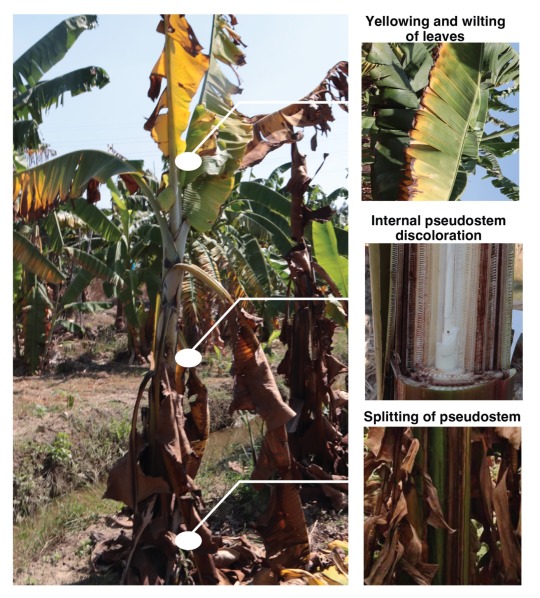
External Symptoms of FWB in Cavendish bananas. Credit: Zhang et al.
The team still doesn’t know how this gas specifically contributes to disease infestation in Cavendish banana. However, they were able to determine that the virulence of Foc TR4 was greatly reduced if the two genes that control nitric oxide production were eliminated.
“Identifying these accessory genetic sequences opens up many strategic avenues to mitigate, or even control, the spread of Foc TR4,” Yong Zhang, study co-author and a postdoctoral researcher at UMASS Amherst, said in a statement.
‘Always Remember To Say Thank You To a Farmer’
In future research, the team would like to better understand how the fungus can produce such a harmful gas without hurting itself. They would like to test various ways to interrupt the production of nitric oxide and explore genes that can take the gas away before it damages plant cells.
Importantly, work like this raises awareness about the dangers of monocropping in agriculture and relying on a single species.
“Growing a single cultivar of any crop, also called monoculture agricultural production, provides breeding ground for the development of pathogens,” says Ma. “To help increase the demand for diverse bananas in the market, we can intentionally pick up different varieties of bananas from the shelf. We can support local producers by shopping locally.”
It is also a lesson in the importance of valuing the time and effort of those who produce all of the food we put on our tables.
“We, consumers, should appreciate that bananas or other fruits/vegetables do not grow from grocery stores,” says Ma. “There are tremendous efforts to bring food to our tables and feed our bodies. Always remember to say thank you to a farmer when you see one with dirt and soil all over his/her body.”
2 notes
·
View notes
Text
NUTRIFLAX
Nutriflax Granules are an innovation in Biotechnology Research. Nutriflax is a non-toxic, eco-friendly research based complete natural food for any crop. Nutriflax contains vitamins A, B, B2, C, Folic acid proteins like amino acid, humic acid and other enzymes and turmeric and probiotics makes product unique.
Benefits:
Early germination.
Vigorous seedling growth.
Profuse primary and secondary root development.
Increased soil microbial activity.
Higher nutrient uptake.
Better branching/tillering and increased foliage.
Reduction in the fruit and flower drop.
Better development of grains/fruits.
Increase in the size and weight of the grains/fruits.
Higher yield and better quality of the produce.
Crops:
For all the commercial crops
Agrifort Technologies
Facebook
Instagram
Youtube
What are Nutriflax Granules?
These granules when applied to soil release nutrients in plant rhizosphere thus stimulate growth of beneficial micro-organisms and provide nutritional support to plant at critical stages of growth. Nutriflax helps the plant against adverse climate condition and provide healthy overall growth of plant system, higher yields,pest & disease resistance. Manufacturing process through probiotic makes the products further unique.
#agribusiness#agritech#agriculture#education#health & fitness#business#nature#agricoltura#agrobisnis#farmers protest#farming#Farmers
3 notes
·
View notes